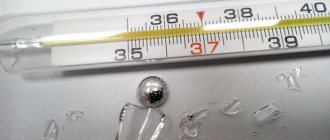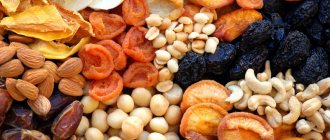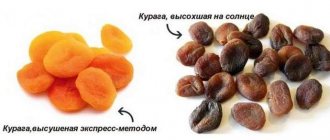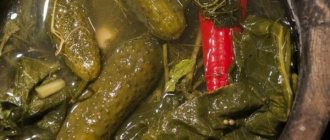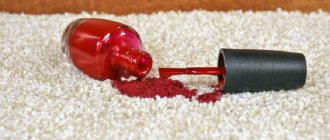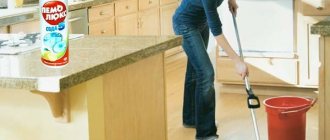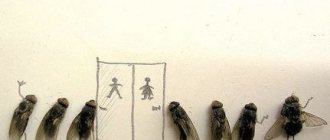Dried fruits are not the main component of the diet, but they are chosen as a healthy alternative to confectionery. They are sweet and healthy: when prepared correctly, they retain trace elements and vitamins. Dried apricots and raisins are champions in potassium and magnesium content; these minerals are especially important for the heart, maintain the rhythm of the heart muscle and improve vascular tone. Prunes also contain a lot of potassium, and they also contain vitamin A and calcium.
When harvesting, some of the vitamins in dried fruits are destroyed. But in terms of nutritional value, they are significantly ahead of store-bought sweets and cookies. In addition to valuable nutrients for the body, they contain fiber, which is necessary to maintain the healthy functioning of the digestive system and cleanse the body of toxins.
Dried fruits are rich in minerals and fiber (Photo: 1zoom.ru)
Dried fruits contain a lot of sugars. As they dry, their quantity does not increase: the same volume that was in one plum is retained in its dried version. But we can only eat a few plums: five to six pieces at a time, and much more prunes. Dried fruits have no moisture and are significantly smaller than regular fruits. Therefore, nutritionists point to their high calorie content. So one small handful of raisins is equal in calorie content to a large bunch of grapes.
Dangerous sulfur dioxide
To protect the product from mold and spoilage during storage, manufacturers treat quiche, apricot and plum with sulfur dioxide. This gas works real miracles with fruits. When dried, the fruits do not darken, remain bright and very attractive to the buyer. An important plus is that they are not afraid of any microorganisms.
But this connection is dangerous for humans. Sulfur dioxide, which is designated food additive E220 on product packaging, is extremely toxic. Its high concentrations cause suffocation and pulmonary edema in humans. And the small ones are unpleasant “symptoms” of ARVI:
- sore throat;
- coughing;
- hoarseness;
- runny nose.
Fruits treated with sulfur dioxide look perfect (Photo: Pixabay.com)
90 percent of dried fruits on the market are treated with sulfur dioxide. Traders claim that sanitary control simply does not allow unprocessed fruits to cross the border. In addition, organic, safe alternatives do not sell very well: buyers prefer amber raisins and spectacular yellow dried apricots to their shriveled and dark counterparts.
Prunes
In order for prunes to become as beneficial as possible for the body and especially for the intestines, before eating they must be soaked in cool water for half an hour. After this time, the liquid must be drained and the dried fruits rinsed under hot running water.
Cheap, simple and necessary: how to turn old jeans into table napkins
Einstein said what you need to do to understand what kind of person is in front of you
Carrots, radishes and other foods that will help fight the runny nose
However, please note that this processing method is only suitable for prunes intended for fresh consumption (for example, to add to a salad).
If in the future the fruits will be used for cooking compote or baking, then it is better to treat it with boiling water (but also after soaking).
Safety regulations
Sulfur dioxide is an extremely unstable substance. It dissolves well in water, so getting rid of it is easy:
- rinse dried fruits purchased at the market or in a store;
- pour them into a bowl and cover with cold running water;
- leave for an hour, then drain the water and rinse the fruits again;
- Fill with water again and leave for another hour.
Soak dried fruits for at least two hours (Photo: Alcovolna.ru)
After such a long soaking, the fruits can be eaten, they will be safe. But keep in mind a few more nuances.
- Don't buy the most beautiful dried fruits. Treatment with sulfur dioxide does not make them more tasty or of higher quality. The less of this substance gets on dried apricots or raisins, the better. Therefore, choose those fruits that are more similar to naturally dried ones. They are distinguished by a dark crust, natural “wrinkling”, and spots on the surface.
- If a film appears on the water during soaking, immediately drain the water and soak again. Dried fruits are often treated with glycerin or fat to make them soft and glitter enticingly in the sun. This film does not allow sulfur dioxide to evaporate, which is why its high concentration may remain in the fruit. There should be no film on the water when soaking fruits.
- Avoid buying and eating fruits that have an unpleasant odor. Usually dried fruits do not smell at all, and this is normal. It's another matter if they emit a burning or fuel smell. This means that they were dried in ovens running on diesel fuel or gasoline. With this harvesting method, carcinogenic substances are concentrated on the surface of the fruit.
Soaking allows you to remove not only dangerous sulfur dioxide from dried fruits, but also additional sugar, which is used to process some fruits (cherries, dates). Water also washes away liquid smoke, sand, and dyes well. Thorough rinsing and soaking for two hours will make the dried fruit safe and bring back the natural taste.
When should you eat dried apricots?
You can use the product before bed, but in moderation. If you adhere to a dietary diet, then you should eat dried fruit in the morning or afternoon - before 16:00. The calorie content of dried apricots per 100 grams of product is 215 kilocalories.
Interesting materials:
Where did the name Volgograd come from? Where did the name of the Syrdarya River come from? Where does the name of the Chinese horoscope come from? Where did the name pancakes come from? Where did the name Yeralash come from? Where did the name of the city Vladimir come from? Where did the name of the group Alice come from? Where did the name Mariupol come from? Where did the name Toyota come from? Where did the name sprats come from?
Danger #2: Strange taste
“Drying plum fruits naturally, in the shade or in the sun, is quite difficult; they quickly turn sour,” says Nadezhda Semenova. “Therefore, they are dried in an accelerated way in gas or gasoline ovens at high temperatures. When prunes, dried apricots, and raisins take on the taste of gasoline, the skin cracks, carcinogens settle on it, and the vitamins and enzymes inside die.”
How to protect yourself : when buying dried fruits, take a good sniff. The smell of gasoline and smoke leads to suspicion. Severely cracked dried fruits are a defect. Buy dates with pits, raisins and prunes with stems. Such fruits retain nutrients better.
Medicinal properties of dried fruits
Dried fruits can become a real cure for many diseases. Here is a partial list of the benefits the most popular ones bring to the body.
Candied orange peel
effective in the treatment of asthma, bronchitis and pneumonia, have antibacterial properties, reduce the risk of developing cancer of the skin, breast and colon, improve the functioning of the gastrointestinal tract, prevent constipation, gas formation, heartburn and vomiting. They are able to improve mood and stabilize the nervous system, normalize sleep.
Raisin
has a beneficial effect on the functioning of the kidneys and cardiovascular system, improves immunity.
Figs
improves metabolism and heart function, replenishes strength and energy, and is useful for fighting tumors. Figs with warm milk helps with dry cough. A large number of vitamins and minerals make it an indispensable remedy for those recovering from illness or surgery.
Dried apricots
normalizes the functioning of the cardiovascular system, liver and pancreas, improves digestion, rids the body of toxins and waste, and reduces cholesterol levels. It is useful for brain function, improves immunity, activates the production of collagen and hyaluronic acid - prevents skin aging. Kumquat is a powerful antioxidant and source of vitamin C. It improves immunity, fights infections and parasites, removes salts and toxins, suppresses the action of fungi and kills bacteria, and helps fight infections. Kumquat is used to prevent strokes, for diseases of the nervous system, and to relieve stress and tension.
Dried apples
improve metabolism and promote the renewal of body cells, stimulate the process of hematopoiesis, improve the condition of hair and skin, provide the body with energy, reduce the risk of developing cancer, and are beneficial for the functioning of the circulatory system and heart.
Dried apricots
helps with migraines, strengthens the immune system, improves intestinal motility, removes excess fluid, relieves swelling, improves hemoglobin synthesis, and stimulates tissue energy exchange. It is a natural source of iron, carotene, potassium, magnesium and phosphorus.
Dates
increase hemoglobin, regulate the amount of glucose, improve intestinal motility, help the cardiovascular system, fight fatigue, strengthen the immune system, and can even have an antipyretic effect.
Prunes
lowers blood pressure, has choleretic and diuretic properties, strengthens the immune system and calms the nerves.
Recipes
Tasty and inexpensive: we offer a couple of simple recipes with dried apricots.
Healthy candies
Beat dried apricots in a blender, add finely chopped and lightly fried pieces of peanuts, almonds or hazelnuts. If desired, add a pinch of cinnamon. Form balls with your hands, prick them onto skewers, dip in melted chocolate, and place to cool on cellophane or a silicone mat.
Where to produce and on what?
For the production of dried fruits, significant areas with sufficient premises will be required. Here is the required minimum of workshops that you will need:
- Procurement;
- drying;
- processing;
- packaging;
- warehouses for finished products.
In addition, it is necessary to have effective sewerage and ventilation systems, a 3-phase electrical network (380V) for connecting industrial equipment, and water supply.
The choice of equipment is more free; the market offers a wide range of devices with different functional features and prices. With small-scale production, you can do without technological equipment, performing all processes manually. However, this approach will be unproductive and ineffective: manual work is more expensive and at the same time less productive in comparison with the use of automated machines; the quality of such products also often leaves much to be desired. Therefore, if you plan to build a profitable business in the production of dried fruits with prospects for growth and development, you should initially ensure acceptable competitiveness. And the use of professional equipment will become one of your competitive tools.
The key element of the technical equipment complex for the production of dried products is the drying unit. There are various types of such equipment on the market, among which you need to choose the appropriate option taking into account the specifics and scale of your activity:
- For small production volumes, cabinet dryers with an affordable price are suitable.
- If you plan to produce medium volumes of product, then you should pay attention to boxed devices; they have a relatively low cost and at the same time sufficient productivity and degree of labor automation.
- Large production facilities are equipped with belt dryers, which are suitable for processing a wide range of fruits and perform most operations automatically.
- To work with fruits containing a large volume of juice, it is recommended to use tunnel dryers; this type of equipment is optimal for the production of prunes, raisins, dried apricots, etc.
Various types of ovens can also be used, including infrared, manual and automatic centrifuges, etc.
In addition to the drying equipment itself, a whole range of other equipment is needed:
- Industrial scales;
- instruments for cleaning and preparing fresh raw materials;
- containers of certain sizes;
- packaging equipment;
- warehouse equipment;
- freight transport – if the delivery of raw materials to production and finished products to sellers is carried out independently.
Significant savings on initial investments can be achieved by purchasing a simple drying chamber that requires constant monitoring by operators. Such equipment is several orders of magnitude cheaper than automated lines, but their productivity is significantly lower.
